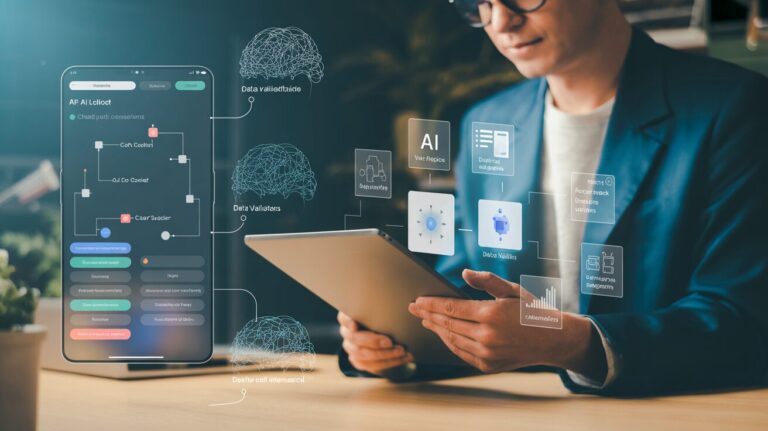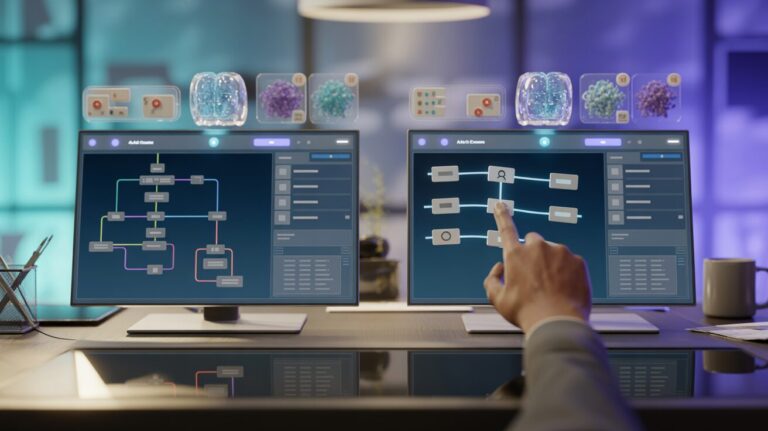Table Of Contents
- Understanding Event-Driven AI: The Basics
- Traditional vs. No-Code Approaches to Cloud Functions
- Benefits of Implementing Cloud Functions Without Code
- Getting Started: Building Your First Event-Driven AI Application
- Practical Use Cases for No-Code Event-Driven AI
- Choosing the Right No-Code Platform for Event-Driven AI
- The Future of No-Code Event-Driven AI
Imagine being able to create sophisticated AI applications that automatically respond to specific events or triggers—without writing a single line of code. This isn’t a future possibility; it’s today’s reality with event-driven AI and no-code cloud functions.
For too long, implementing event-driven AI solutions required extensive programming knowledge, cloud infrastructure expertise, and significant development time. This technical barrier has kept powerful AI capabilities out of reach for many professionals who could benefit most from them—from content creators and educators to healthcare providers and small business owners.
The good news? A revolution is underway. No-code platforms are democratizing access to event-driven AI, allowing anyone to create applications that respond intelligently to triggers and events through simple visual interfaces. In this comprehensive guide, we’ll explore how you can leverage cloud functions without coding to build powerful, responsive AI applications that transform your workflow, enhance user experiences, and open new possibilities for innovation.
Event-Driven AI Without Code
Revolutionizing how professionals build AI applications
What is Event-Driven AI?
Applications that remain dormant until triggered by specific events—saving resources while ensuring immediate, intelligent responses exactly when needed.
The No-Code Revolution
Visual interfaces replacing complex coding with drag-and-drop functionality, putting powerful AI capabilities in the hands of subject matter experts rather than technical specialists.
Traditional vs. No-Code Development
Traditional Approach
- Writing code in Python, JavaScript, or Go
- Configuring complex cloud infrastructure
- Setting up event triggers through APIs
- Multiple testing and debugging iterations
- Continuous monitoring and maintenance
No-Code Approach
- Selecting pre-built components visually
- Defining triggers through dropdown menus
- Connecting triggers to actions with drag-and-drop
- Testing in real-time with visual feedback
- Deploying with a single click
Reduced Development Time
From weeks to hours, dramatically accelerating time-to-value
Democratized Access
Bringing AI capabilities to domain experts, not just technical specialists
Lower Costs
Significantly reduced expenses for development and ongoing maintenance
Getting Started in 6 Simple Steps
Define Purpose
Clearly outline objectives
Map Triggers
Identify activation events
Design Flow
Map out logical steps
Configure AI
Select AI capabilities
Test & Refine
Simulate real scenarios
Deploy & Monitor
Launch with a single click
Practical Use Cases
Customer Experience
Intelligent chatbots that respond to specific behaviors with personalized recommendations
Content Moderation
Systems that automatically analyze user content as it’s submitted
Healthcare Monitoring
Applications that monitor patient data and trigger alerts for vital sign anomalies
Educational Assessment
Adaptive learning systems that analyze performance and create personalized paths
Start Building Your AI Application Today
Create custom AI applications in minutes without coding knowledge
Estha AI — Democratizing artificial intelligence for everyone
Understanding Event-Driven AI: The Basics
Event-driven AI represents a paradigm shift in how applications operate. Instead of constantly running processes, event-driven applications remain dormant until triggered by specific events—saving resources while ensuring immediate responses when needed.
At its core, event-driven AI follows a simple principle: when X happens, do Y. The “X” might be a user uploading a document, a specific time of day, a change in data, or virtually any detectable trigger. The “Y” is the intelligent response—perhaps analyzing the document, sending personalized notifications, or making predictions based on the new information.
Cloud functions (also called serverless functions) are the backbone of modern event-driven architecture. These are snippets of code that execute in response to specific triggers without requiring you to provision or manage servers. Major cloud providers like AWS (Lambda), Google Cloud (Cloud Functions), and Microsoft Azure (Functions) all offer these capabilities—but traditionally, you needed coding expertise to use them.
The key components of event-driven AI include:
- Event sources: The triggers that initiate processing (user actions, database changes, API calls, etc.)
- Event routers: Systems that direct events to appropriate handlers
- Function handlers: The code that executes in response to events
- AI processing: Machine learning models that analyze data or make decisions
Traditionally, implementing this architecture required expertise in multiple programming languages, cloud services, and AI frameworks. No-code platforms have changed this equation entirely.
Traditional vs. No-Code Approaches to Cloud Functions
Before no-code platforms emerged, implementing event-driven AI followed a complex, technical path that created significant barriers for non-developers.
The Traditional Approach
With conventional development, creating event-driven AI applications typically involves:
- Writing function code in languages like Python, JavaScript, or Go
- Configuring cloud infrastructure through command-line interfaces or consoles
- Setting up event triggers through service-specific APIs
- Integrating AI services or building custom models
- Testing and debugging through multiple iterations
- Monitoring and maintaining infrastructure over time
This approach requires specialized skills in software development, cloud architecture, and AI—a combination rarely found in one individual and certainly not accessible to non-technical professionals.
The No-Code Revolution
No-code platforms transform this process through visual interfaces that abstract away the complexity. With platforms like Estha, the event-driven AI creation process becomes:
- Selecting pre-built components from a visual interface
- Defining triggers through dropdown menus or simple configurations
- Connecting triggers to actions with drag-and-drop functionality
- Customizing AI responses without programming knowledge
- Testing in real-time with immediate visual feedback
- Deploying with a single click
This democratized approach puts powerful AI capabilities in the hands of subject matter experts rather than limiting them to technical specialists. The result? More diverse, creative, and industry-specific AI applications built by the people who understand the problems best.
Benefits of Implementing Cloud Functions Without Code
The shift to no-code event-driven AI brings transformative advantages that extend far beyond simple convenience:
Dramatically Reduced Development Time
What once took weeks or months can now be accomplished in days or even hours. By eliminating the need to write code, debug issues, and manage infrastructure, no-code platforms compress the development timeline dramatically. This rapid development enables quick iteration and faster time-to-value for AI initiatives.
Democratized Access to AI Capabilities
Perhaps the most significant benefit is bringing AI development capabilities to non-technical experts. Healthcare professionals can build patient assistance chatbots, educators can create personalized learning tools, and small business owners can develop customer service AI—all without depending on technical teams or expensive consultants.
Reduced Costs
Traditional software development comes with substantial costs: developer salaries, infrastructure management, and ongoing maintenance. No-code platforms significantly reduce these expenses, making sophisticated AI applications financially viable for individuals, small businesses, and departments with limited budgets.
Focus on Domain Expertise
When subject matter experts can directly build AI applications, the resulting solutions better address real-world needs. Instead of translating requirements to technical teams (with inevitable information loss), domain specialists can directly implement their vision and fine-tune applications based on their expertise.
Easier Maintenance and Updates
Traditional code requires ongoing maintenance as platforms evolve and requirements change. No-code solutions typically handle infrastructure updates automatically, and the visual interfaces make modifying functionality straightforward even after the initial implementation.
Getting Started: Building Your First Event-Driven AI Application
Creating your first event-driven AI application without code is remarkably straightforward with platforms like Estha. Here’s a general approach that applies to most no-code AI platforms:
Step 1: Define Your Application’s Purpose
Start by clearly defining what you want your application to do. Are you creating a customer service chatbot that triggers personalized responses? An inventory management system that automatically reorders supplies when levels drop? A content moderation tool that reviews uploads in real-time? Having clarity on your objectives will guide all subsequent decisions.
Step 2: Map Out Your Event Triggers
Identify the specific events that should activate your application. These might include:
- User actions (form submissions, button clicks, uploads)
- Time-based triggers (daily reports, scheduled checks)
- Data changes (inventory levels, price changes, new entries)
- External system events (API calls, webhook notifications)
Step 3: Design Your Application Flow
Using the visual interface of your chosen no-code platform, map out the logical flow of your application. With Estha’s drag-drop-link approach, you can create sophisticated process flows by connecting different components—triggers, data processing steps, decision points, and actions—into a coherent workflow.
Step 4: Configure AI Components
Select and configure the AI capabilities your application needs. This might include:
- Natural language processing for understanding user requests
- Image recognition for processing visual content
- Predictive analytics for forecasting trends
- Recommendation engines for suggesting products or content
Most no-code platforms offer pre-configured AI components that can be customized to your specific needs without requiring machine learning expertise.
Step 5: Test and Refine
Before deployment, thoroughly test your application with realistic scenarios. Most no-code platforms provide built-in testing tools that allow you to simulate triggers and verify responses. Use these insights to refine your application’s logic and improve its performance.
Step 6: Deploy and Monitor
With testing complete, deploy your application with a single click. After deployment, monitor its performance to ensure it’s functioning as expected and meeting your objectives. Most platforms provide analytics dashboards that offer insights into usage patterns, performance metrics, and potential improvements.
Practical Use Cases for No-Code Event-Driven AI
The versatility of no-code event-driven AI enables applications across virtually every industry. Here are some compelling examples:
Customer Experience Enhancement
Build intelligent chatbots that engage customers when they exhibit specific behaviors (like dwelling on a page or abandoning a cart). These AI assistants can offer personalized recommendations, answer questions, and provide support—all triggered by real-time customer actions and tailored to their specific context.
Content Moderation and Management
Create systems that automatically analyze user-generated content as it’s submitted, flagging potentially inappropriate material for review or categorizing submissions for easier management. These applications can process text, images, and even video without human intervention for most content.
Healthcare Monitoring
Develop applications that monitor patient data from wearables or electronic health records, triggering alerts when vital signs fall outside normal ranges or when medication adherence issues are detected. These systems can also provide personalized health recommendations based on changing patient conditions.
Educational Assessment
Build adaptive learning systems that analyze student performance on assessments, automatically generating personalized learning pathways based on identified strengths and weaknesses. These applications can trigger different educational content depending on individual student needs.
Business Process Automation
Create sophisticated workflow automation that responds intelligently to business events—processing invoices when they arrive, routing approvals based on content analysis, or triggering inventory reorders when supplies reach threshold levels.
Choosing the Right No-Code Platform for Event-Driven AI
With numerous no-code platforms emerging, selecting the right one for your event-driven AI needs requires evaluating several key factors:
Ease of Use vs. Flexibility
Platforms range from extremely simple (but possibly limited) to highly flexible (but with steeper learning curves). Consider your technical comfort level and the complexity of your intended applications. Estha strikes an impressive balance, offering powerful capabilities through an intuitive drag-drop-link interface that remains accessible to non-technical users.
AI Capabilities
Evaluate the depth and breadth of AI functionality. Does the platform offer the specific capabilities your applications require—natural language processing, image recognition, predictive analytics, or custom AI model integration? The best platforms provide both pre-built AI components and customization options.
Integration Options
For event-driven applications, connectivity is crucial. Assess the platform’s ability to integrate with your existing systems, databases, and third-party services. Look for pre-built connectors to common services and webhook support for custom integrations.
Scalability
Consider whether the platform can grow with your needs. Will it handle increasing volumes of events? Can it support more complex applications as your requirements evolve? The underlying infrastructure should scale automatically as your usage grows.
Support and Community
Evaluate the resources available for learning and troubleshooting. Strong documentation, responsive support, and active user communities significantly enhance your chances of success. Platforms like Estha that offer educational resources through programs like EsthaLEARN provide valuable support for new users.
Deployment and Distribution Options
Consider how you’ll share your applications with users. Can you embed them in existing websites? Are there mobile deployment options? Can you share them with specific communities or monetize your creations? The most versatile platforms offer multiple distribution channels.
The Future of No-Code Event-Driven AI
As no-code platforms continue to evolve, several emerging trends will shape the future of event-driven AI development:
Increased AI Sophistication
No-code platforms will incorporate increasingly advanced AI capabilities, allowing non-technical users to implement sophisticated machine learning models, natural language understanding, and computer vision without specialized knowledge. This democratization will accelerate innovation across industries.
Hybrid Approaches
The line between code and no-code will continue to blur, with platforms offering seamless ways to extend no-code applications with custom code when needed. This hybrid approach will provide the perfect balance of accessibility and flexibility.
Enterprise Adoption
As no-code platforms mature in terms of security, compliance, and governance features, enterprise adoption will accelerate. Large organizations will increasingly empower business units to create their own AI solutions while maintaining necessary oversight.
AI-Assisted Creation
In a fascinating recursive development, AI itself will increasingly assist in the creation of AI applications. Future platforms will suggest optimal workflows, automatically identify needed components, and even generate applications based on natural language descriptions of desired functionality.
Specialized Industry Solutions
No-code platforms will increasingly offer industry-specific templates, components, and workflows tailored to particular sectors like healthcare, education, finance, and retail. These specialized solutions will further reduce the effort required to implement AI in specific domains.
Embracing the No-Code AI Revolution
The ability to implement event-driven AI without coding represents nothing less than a democratization of one of today’s most powerful technologies. By removing technical barriers, no-code platforms are enabling a new wave of innovation led by domain experts rather than programmers.
This shift has profound implications. Healthcare professionals can create AI assistants that improve patient outcomes. Educators can build personalized learning experiences that adapt to individual needs. Small business owners can implement sophisticated customer engagement systems that previously required enterprise budgets.
As these tools continue to evolve, the possibilities will only expand. The question is no longer whether you can implement AI in your work or business—it’s what you’ll choose to build first.
Event-driven AI without code isn’t just a convenience; it’s an invitation to participate in shaping how artificial intelligence transforms our world. And platforms like Estha are making that invitation accessible to everyone, regardless of technical background.
Ready to Build Your Own Event-Driven AI Application?
Create custom AI applications in minutes without coding or prompting knowledge. Join the no-code AI revolution today!



